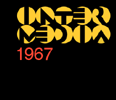public record
<-- previous | next -->
The VANCOUVER SUN
August 1969
About Art...
Boxes: A New Form?
by CHARLOTTE TOWNSEND
"Boxes; the whole idea of the boxes, is more important than just me, or any one of us. What we are doing is exploring them as a new sculptured medium."
During his two years in Vancouver Bob Arnold, a young Californian artist who has been "kind of picking away at sculpture ever since I was a kid," has become more and more intrigued by the possibilities of the box, and a lot of other people have gotten just as intrigued as Arnold.
"I'm very excited by the whole collaborative thing that's happening in Vancouver; and its so apparent that Michael de Courcy and I can collaborate to our mutual advantage."
de Courcy, one of the most inventive photographers here, is working on the various possibilities of the boxes. He plans to make literally, a box camera, on the principle of the original camera obscura.. The image of its environment as 'seen' by the box would then be applied to the exterior . The effect when the boxes were arranged in say a ziggurat formation can only be imagined at this stage.
Already arnold has realized new dimensions of what he has done through de Courcy's version, (see illustration) not least the graphic potential of this kind of form making.
Gary Lee Nova is interested in the structural possibilities, and is experimenting with the ways of coloring boxes and combining them with mirrors.
"Henry Rappoport wants to put poems on boxes, to make a six page instant book. Another extension would be to use a high-quality surface paper and paint or draw on it. You'd have six images sitting on your table and you would really read it or look at it.
"I like the idea of an object that makes people very willing to pick it up for a closer look and feel; an object that isn't antiseptic. I want to get rid of the preciousness, I really shy away from producing precious, private objects."
Instead Arnold is using the cardboard box, the commonest and cheapest version of right angled space, to create an infinite number of forms related to their own space. The interest began when "a man at Crown Zellerbach suggested boxes instead of one large piece of cardboard when i was wanting to make the tunnel (Arnold's contribution to Intermedia's Electrical Connection at the Art Gallery earlier this year.) Since having all those modules to work with, I haven't looked back.
"They're modular, multiples, disposable. They're funky, versatile, light weight, allowing for very improbable structures. There are no storage or preservation problems. They only need to be taken on there own terms, as objects without any aesthetic fat around them. This is the object off a pedestal, something to rest your eyes on;it shouldn't be anything else.
"When it comes to sculpture there are two things in the place . . . there's the sculpture and there's me. If there's other stuff that my body, I, (its the same thing,) have to contend with then then I become much less part of the piece. The "art", "sculpture", whatever you want to call it, happens somewhere between us, There's a little place where we meet. The less that encroaches on that space the better."
This makes Arnold,s definition of perimeter, it explains the importance he attaches to the environment in which the box arrangements operate and why he wants to create "environments" as such.
The big trouble with every environment I've ever been in is that you can always see the seems, there are always to many clues to tell you that it is a trumped up space. The 'environment' that he plans with Lee Nova for their joint show at the UBC Gallery in January will consist of only two visual elements, boxes and tar paper with no light sources. The ultimate work of which Arnold dreams would be a a huge structure of assorted boxes. Once inside that would be absolutely all you could see, with the help of a flashlight.
"No one has really tripped on the importance of the perimeter. I almost feel like saying that a piece isn't valid without a perimeter. We have to admit that size and exclusiveness are as much visual elements as the form itself.
Arnold has lived with about 500 boxes in his living room< testing the different ways of relating them to its space. He has set up structures around the city, always considering the space, positive and negative, that they will occupy. He is going to spend the winter in the Kootnays, where there is more space and he can observe the effects of snow on the boxes. He will take with him a lot of glue and 18 inch cubes (bought with a $500.00 materials grant from the Canada Council).
"I won't have enough to do everything I want. I need a lot so that they can be expendable. so that I can leave boxes anonymously around the city and around the Kootenays.
"I am trying to build a working liaison with Crown Zellerbach. Without them and their cooperation the trip can't go much further. They invented the box as a medium. I pointed it out as an art medium. It gives many new dimensions to their product; within a couple of years I am sure a lot more people will be incorporating boxes into their work.
public record
<-- previous | next -->
